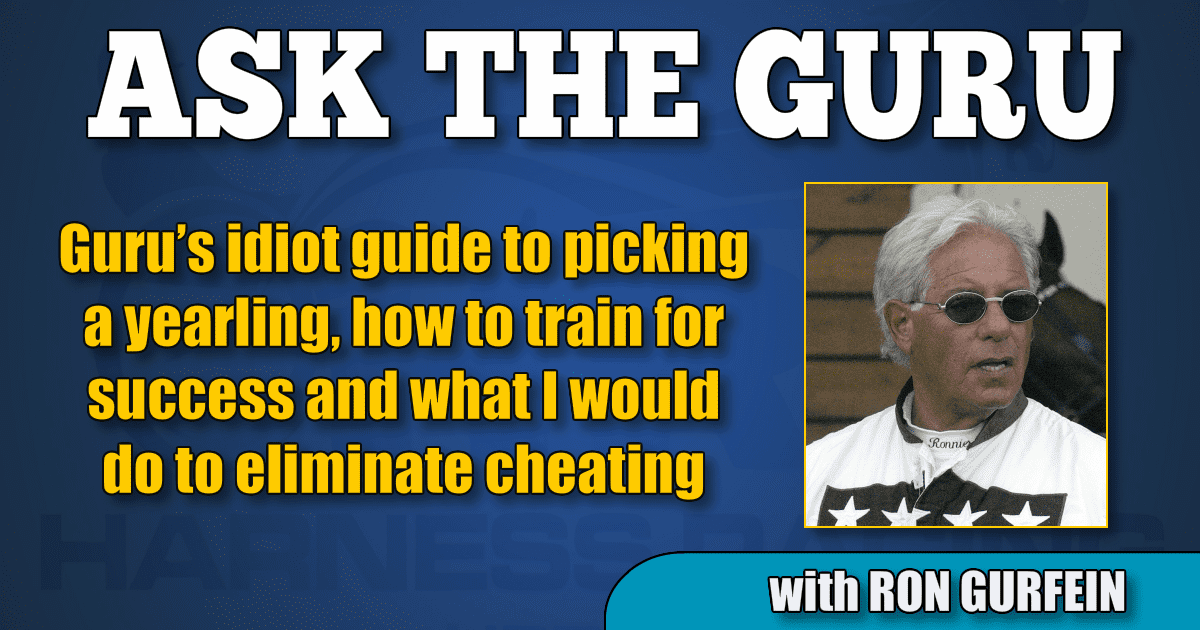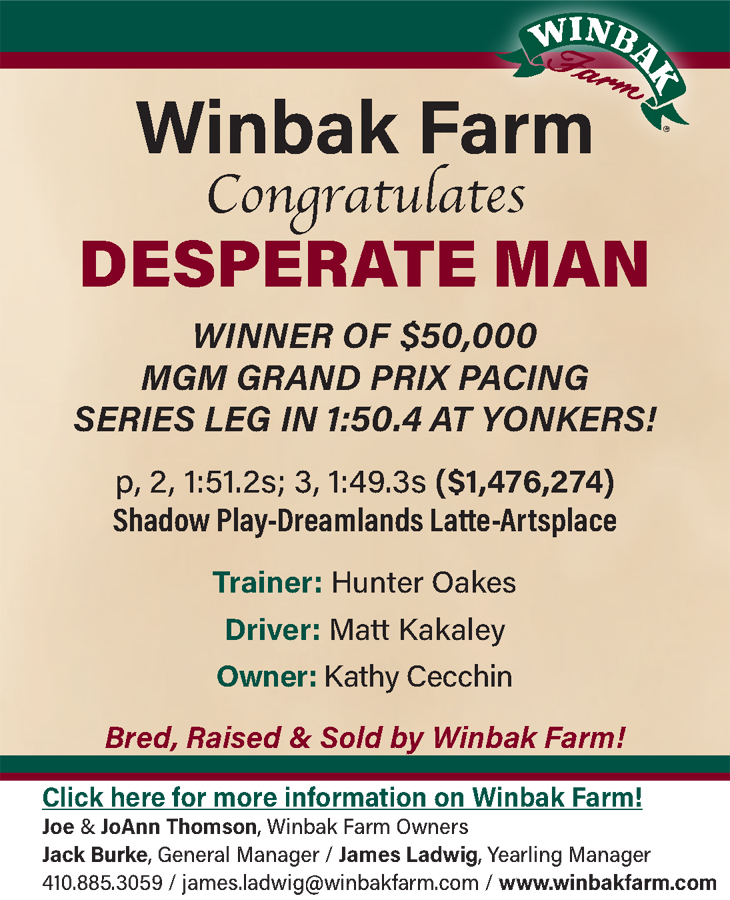My idiot’s guide to picking a yearling, how to train for success and what I would do to eliminate cheating
by Ron Gurfein
Tidbits: I heard nothing but EXPENSIVE in regard to the new restaurant in Lexington, Jeff Ruby’s. So I decided to try it myself. High-end items are high-priced but you don’t need caviar and steak.
I found the place charming. The service was fabulous. They have a wildcat blue (Kentucky University sports) Grand Piano on stage behind the bar with Keith at the keys, pouring out classic tunes like at a New York cabaret in the 1950’s. I had a half bowl of crab and corn chowder soup, a sushi dish, a martini and a glass of sparkling water for $40. Very reasonable for good food and entertainment. The place is beautiful on top of that. They do charge $8 to valet so I suggest walk if you can.
For value I still think Le Deauville has the best food and ambiance in the city. It has been my mainstay for over a decade. Tuesday night is all you can eat mussels and this week my buddy Art Zubrod ate three portions and he is a skinny fellow. It is a must try and they stay open late during the sale to accommodate the buyers. Expect slow service, it’s a part of the French scene.
Debbie Long’s Dudley’s On Short is my favorite lunch spot as well as Tashibana and it’s fine Japanese fare. The lunch specials are reasonable and delicious. Other choices I am fond of include: Coles basic southern kitchen with great variety and the Holly Hill Inn a little off the beaten path but well worth the journey. The brunch is sensational. The owner and chef Ouita Michel is world renowned.
It should be a unique meet at the Red Mile this year. To those of you that don’t believe in global warming the race time temperatures are predicted to be in the mid-nineties the entire week. Records will tumble. If you are a fan this well could turn out to be a meet for the ages. As Roger would say, “Be there.”
Talking about having a $1 million yearling, I had three on my list when I came to Kentucky that I thought if they looked the part there was a possibility they would fetch seven figures. I have seen all three and the only reason they all can’t be the one is that the Muscle Hill colt from the great mare Bee A Magician is out of the sale. There still are a few with a good chance and I have added one that puts me back at three. It will be fun.
The Guru’s Idiot’s Guide for Selecting a Yearling
I have given my guidelines for buying yearlings too many times to bore you to death. For those of you that have never read my advice, here is a quick guideline to how to appraise a yearling:
When the colt walks out of the stall he should be on his toes stepping out and not dragging his feet. When he walks I like him picking up his feet, not shuffling. When he stands in front of you, all joints should match knees, ankles, and hocks look alike and point straight ahead. The bump in his back just below his neck is called his withers. If you are 5’10” and you put your hand there and it seems like it’s pointing way down for the most part the colt is too small. To me there is no such thing as too big. The distance from the withers to the bottom of his belly should be at least 30+ inches. You don’t want a colt with no girth which is what that area is called. Now stand behind the colt. Not close enough to get kicked. When you are directly behind him, his butt should be wide. If it’s less than 25 inches, look elsewhere. The bigger the better.
Note: these guidelines are for fun, not to go out and buy a colt. It’s written so you have some idea as to how to buy a yearling. A colt can very well have positive results to all my suggestions and still have a major fault. I write this to enhance the novice enjoyment of the sales experience. PLEASE, when it comes to spending real money consult a professional.
Alain Truyen asks: You have trained many horses during your career, have you prepared them all in the same way? Can you tell us the proper program for success?
It’s impossible to train all your horses the same way from start to finish because of a difference in individual needs.
Just like conditioning the human athlete, some are in better shape to begin with than others. Some colts come in looking like they are ready to put in the box, some are too fat, some are too thin, some have good muscle tone and some have none.
This is why I preach that a trainer must be successful in the “draft,” my words for the auction ring, in order to have great horses to train.
If you buy the best, training will not be such an uphill climb. Training methods are no secret, but selecting the horse takes special talent. If you are not sure you are capable ask someone who is.
The following is what I consider the perfect training schedule:
By the time your colt is broken properly he has jogged a couple of miles a day for a while. Start jogging him three miles a day for a month and a half. I am used to Sunshine Meadows which is much slower than most tracks so I will use slightly faster times than I would there. I don’t believe in training twice a week and I do believe in mixing the works between the straight track and the circle, to avoid boredom to the trainer and the colt
To begin your schedule, jog one mile and go two miles the right way 4 minutes and 3 minutes. Jog three days.
Go four intervals on the straight track at a 45 second clip.
Jog three days.
Jog two miles and turn and train a mile in 3:30, but brush the last quarter around 43 seconds. Continue this nine-day program and by May 1st your colt will be ready to roll. Try not to drop your times more than five seconds per session and increase your intervals by two every month till you get to 10. Please don’t over-jog your horse it’s a waste of time and energy. Three miles is sufficient. Note, if you have a looney one, that’s a different story. If you have any further questions don’t hesitate to ask.
Pete Richardson asks: If you could do anything you want, money not being an object, what would you do to eliminate cheating in our sport?
Great question, and I am not sure I have the right answer. My theory, as well as many other horsemen, is that the positives we read about are nonsense. Blood doping is the problem and I think the use of EPO is widespread. We need the cooperation of trainers at the top to begin with. Let’s start with the best horses. Take the top three or four on the list and have 24 hour surveillance for 10 days. Then do the same for the next three or four. Arbitrary selection of a horse with form reversal should be included. Try it for a month. Just the fact that it is happening will slow down the criminals. A far less expensive method would be to have a blood count taken on the first of every year on every horse as a base line. Then when you see a radical change in performance the presiding judge should require blood to be taken by a state vet when the horse is cooled out to ascertain if the red cell count has been boosted. If so, that horse becomes one to watch 24/7. I am sure this sounds impossible to most of you, but I put it out there because there is little other choice. If the chemists on our side could come up with a way to test for blood doping it would be a panacea.
I have received plenty of flak from the readers about my crusade against cheating, most of which I feel comes from the criminals themselves. I will not be phased by the outcry and will do anything I can to reduce the size of this mess.
JL Biever asks: In the first heat of the jug it looked like Yannick’s horse tried to kick him out of the bike. What are some of your less than pleasant experiences?
Yannick’s horse was De Los Cielos Deo, translation, from the heavens or Lord of the skies. Oddly, he is neither. He was one of my top yearlings and started out great and then some personality issues emerged. One never knew which colt would show up on race days, the good Deo or the bad Deo. No one can get a colt out of the gate faster than Yannick, and in the pre-race interview he told the TV audience he was going to try and cut the mile. That said, De Los Cielos Deo obviously did not appreciate Yannick’s urging and did try to kick him out of the bike, an event that, knowing the colt’s attitude, came as no surprise to me. The Burkes know what to do.
As far as my harrowing experiences, there were few that were noteworthy. I have been kicked more times than I can count, but it goes with the territory. The worst came on the day before my daughter Lauren was born. It was about 5 degrees and windy in Monticello, a normal January day and in the middle of a mile a colt feeling good in the wind kicked at me and slipped in the snow. I went ass over tea kettle and broke my shoulder. I was in terrible pain but the sight of my daughter the following day changed everything. Continentalvictory has left me with a few scars and I have been kicked by fillies first time hooked to the bike, but that’s about all the tales to tell. Sorry.
Thanks to all my readers for the kind words. I am looking at yearlings in the Bluegrass and have had wonderful compliments from all the horseman at the farms I have visited on the HRU columns. Much appreciated. If there is a water witch out there somewhere, the Bluegrass is now Browngrass and we desperately need rain. See what you can do. Grand Circuit begins at the Red Mile Thursday through Sunday this week and next and if you like betting on the Red Mile races, remember all the races are daytime this year. Post time for the great programs is 1 p.m. Also on Friday, the Dayton Pacing and Trotting Derby’s are Friday night. Have a wonderful week.

















